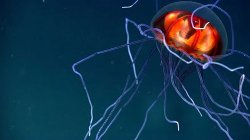The 6 stinging jellyfish you’ll want to avoid at the Jersey Shore
Dr. Paul Bologna, Professor, Biology, spoke with Asbury Park Press about the various jellies in our area
Posted in: Biology, In The Media, Marine Biology

New Jersey is known for its beautiful sandy beaches and fun boardwalks, but a painful predator is common in this summertime paradise. Stinging jellyfish have made homes of the Jersey Shore, its bays and coastal rivers.
Dr. Paul Bologna said these gelatinous animals are commonly found across the Jersey Shore during the warmer months.
Jellyfish are about 95% water and are simple creatures, lacking a heart, brain and blood, according to the National Oceanic and Atmospheric Administration.
Yet these animals are successful predators, feeding on sea creatures like plankton, small crustaceans, fish eggs and larvae, Bologna said. As jellyfish get larger, they will consume common bait fish and full-sized fish, he said.
Jellyfish “could be really devastating to fisheries around the world,” said Bologna. “Where you get these big plumes of these guys coming through, they can really knock back fish populations.”
